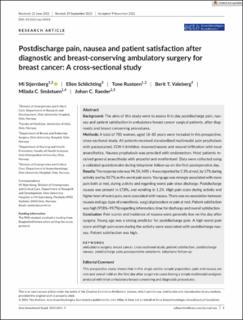| dc.contributor.author | Stjernberg, Mi | |
| dc.contributor.author | Schlicting, E | |
| dc.contributor.author | Rustøen, Tone | |
| dc.contributor.author | Valeberg, Berit Taraldsen | |
| dc.contributor.author | Småstuen, Milada Cvancarova | |
| dc.contributor.author | Ræder, Johan | |
| dc.date.accessioned | 2022-02-18T12:23:55Z | |
| dc.date.available | 2022-02-18T12:23:55Z | |
| dc.date.created | 2021-12-22T12:04:58Z | |
| dc.date.issued | 2021-12-09 | |
| dc.identifier.citation | Acta Anaesthesiologica Scandinavica. 2021, 00 1-9. | en_US |
| dc.identifier.issn | 0001-5172 | |
| dc.identifier.issn | 1399-6576 | |
| dc.identifier.uri | https://hdl.handle.net/11250/2980039 | |
| dc.description.abstract | Background: The aims of this study were to assess first day postdischarge pain, nausea and patient satisfaction in ambulatory breast cancer surgical patients, after diagnostic and breast conserving procedures.
Methods: A total of 781 women, aged 18–85 years were included in this prospective, cross-sectional study. All patients received standardized multimodal pain prophylaxis with paracetamol, COX-II inhibitor, dexamethasone and wound infiltration with local anaesthetics. Nausea prophylaxis was provided with ondansetron. Most patients received general anaesthesia with propofol and remifentanil. Data were collected using a validated questionnaire during telephone follow-up on the first postoperative day.
Results: The response rate was 94.5%. NRS ≥ 4 was reported by 5.3% at rest, by 17% during activity and by 30.7% as the worst pain score. Young age was strongly associated with more pain both at rest, during activity and regarding worst pain since discharge. Postdischarge nausea was present in 17.8%, and vomiting in 1.2%. High pain score during activity and higher level of worst pain, were associated with nausea. There was no association between nausea and age, type of anaesthesia, surgical procedure or pain at rest. Patient satisfaction was high (97.8%–99.7%) regarding information, time for discharge and overall satisfaction.
Conclusion: Pain scores and incidence of nausea were generally low on the day after surgery. Young age was a strong predictor for postdischarge pain. A high worst pain score and high pain score during the activity were associated with postdischarge nausea. Patient satisfaction was high. | en_US |
| dc.language.iso | eng | en_US |
| dc.publisher | Wiley | en_US |
| dc.relation.ispartofseries | Acta Anaesthesiologica Scandinavica;Volume 66, Issue 3 | |
| dc.rights | Navngivelse 4.0 Internasjonal | * |
| dc.rights.uri | http://creativecommons.org/licenses/by/4.0/deed.no | * |
| dc.subject | Ambulatory surgery | en_US |
| dc.subject | Breast cancer | en_US |
| dc.subject | Cross-sectional studies | en_US |
| dc.subject | Patient satisfaction | en_US |
| dc.subject | Postdischarge nausea | en_US |
| dc.subject | Postdischarge pain | en_US |
| dc.subject | Postoperative symptoms | en_US |
| dc.title | Postdischarge pain, nausea and patient satisfaction after diagnostic and breast conserving ambulatory surgery for breast cancer: a cross sectional study | en_US |
| dc.type | Peer reviewed | en_US |
| dc.type | Journal article | en_US |
| dc.description.version | publishedVersion | en_US |
| dc.rights.holder | © 2021 The Authors | en_US |
| cristin.ispublished | true | |
| cristin.fulltext | original | |
| cristin.qualitycode | 1 | |
| dc.identifier.cristin | 1971426 | |
| dc.source.journal | Acta Anaesthesiologica Scandinavica | en_US |
| dc.source.volume | 66 | en_US |
| dc.source.issue | 3 | en_US |
| dc.source.pagenumber | 1-9 | en_US |

